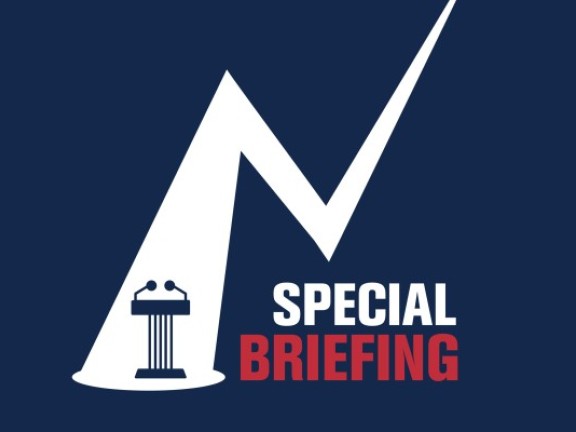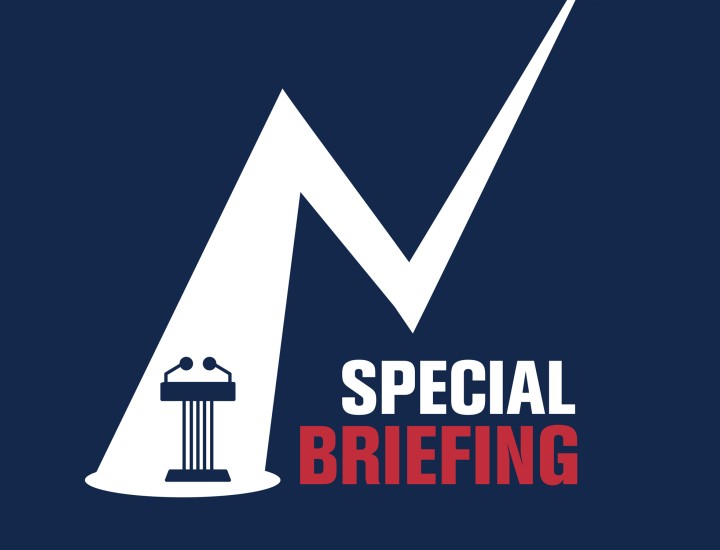Special Briefing on State Budgets: The Big Squeeze

As the widely adopted July 1 start of their new fiscal year approaches, many states are facing fiscal challenges that few governors were anticipating as they delivered their annual budget messages only a few months ago. Even though states started 2025 projecting healthy cash reserves of almost $300 billion, that cushion will be tested by the Trump administration's suspension of tens of billions of dollars in U.S. grants as well as potential cuts by Congress to federal Medicaid funds. A possible threat to the federal tax exemption on most municipal bonds, the impact of a global tariff war, and the rising likelihood of a U.S. recession will also further constrain state and local budgets even as several years of record post-COVID federal stimulus come to an end.
Our expert panel discussed the rapidly darkening outlook for state and local budgets and what this means for policymakers, taxpayers, and investors. Panelists included Jonathan Womer, Director, Rhode Island Department of Administration; Emily Brock, Director, Government Finance Officers Association Federal Liaison Center; Shelby Kerns, Executive Director, National Association of State Budget Officers; Vikram Rai, former Head of Municipal Markets Strategy, Wells Fargo; Teryn Zmuda, Chief Economist, National Association of Counties.
Moderated by William Glasgall, Penn IUR Fellow and Volcker Alliance Public Finance Advisor, and Susan Wachter, Co-Director of Penn IUR and Wharton professor, this briefing was the sixtieth in a series of sixty-minute online conversations featuring experts from the national research networks of the Volcker Alliance and Penn IUR, along with other leading academics, economists, and federal, state, and local leaders.
Special Briefings are made possible by funding from The Travelers Institute, the Volcker Alliance, and members of the Penn IUR Advisory Board. Recordings of the entire Special Briefings series are available on the Volcker Alliance or Penn IUR websites.
Be sure to subscribe to the Special Briefing podcast, available on Apple Podcasts, Spotify, Google Podcasts, TuneIn, iHeart Radio and more.
Subscribe to the Volcker Alliance newsletter and Penn IUR newsletter for advance notice of new Special Briefings.
-----------------------------------------------------------------------------------------------------------------------------------------------------
SPECIAL BRIEFING ON STATE BUDGETS: THE BIG SQUEEZE - EVENT RECAP
State Governments Face Tightening Budget Conditions
Kerns set the stage for a vibrant discussion on the daunting fiscal challenges facing states and municipalities. “State budget conditions overall are tightening,” she said. “There are limited new funds, and states are making hard decisions about which priorities receive funding.” Among the resulting challenges is “the difficulty of managing expectations on all fronts,” said Kerns, “from elected officials, state agencies, the public, and other stakeholders.”
Several factors have coincided to contribute to today’s tightened budget environment. “One is that general fund expenditure growth is outpacing revenue growth in a number of states. Medical inflation is a large driver of that,” Kerns said, noting that “Medicaid makes up about 19% of state general fund spending.”
Multiple Pressures Challenge State Budgets
Beyond a mismatch of revenue and spending, Kerns highlighted the multifaceted challenges that have contributed to serious fiscal shortfalls: “Other budget pressures that states are grappling with right now include education and housing affordability. On the revenue side, we have a slowing economy, as well as the impact of tax reductions that have slowed revenue growth.” On a positive note, “while state budget conditions are tightening and much of the focus is on states’ inability to absorb federal cuts,” said Kerns, “states’ underlying fiscal positions are generally quite strong.”
Local Governments Vulnerable to Federal Budget Shifts
Turning the discussion to municipalities, Zmuda said that “as these federal shifts occur, we can expect to see varied impacts at the local level,” highlighting the heterogeneous nature of the 3,069 county governments across the United States. County-level governments are particularly vulnerable to fiscal disruption at the federal level given their high levels of community reinvestment and typically low amount of reserves. “We are dollar in, dollar out,” said Zmuda.
Historically, counties have relied on a “funding partnership” approach to finance municipal services. In the case of Medicaid, for example, “it’s a partnership between the federal, state, and local government.” Given the numerous uncertainties around the Trump Administration’s fiscal policies, localities must focus on “establishing stability as a top priority,” said Zmuda, to weather potential losses in funding or a broader economic downturn.
Municipal Bonds at Risk: Infrastructure and Tax Policy
Brock spoke on the critical importance of tax exemptions for the $4 trillion municipal bond market. “State and local governments themselves bear 75% of the cost of infrastructure in this country, and we do that by design. We like to make capital decisions locally. But we need to have the market to underpin those streets, clean water, schools, affordable housing, and so much more.”
The fiscal stability of states and municipalities relies in large part on Congress’ continued support of the municipal bond tax exemption. “It costs Congress money to provide the municipal bond,” said Brock, equivalent to “$300 billion over the course of 10 years…one of the top 10 tax expenditures of the federal government.” The tax exemption equates to roughly 200 basis points of savings, or $800 billion. In the absence of the tax-exempt municipal bond, the alternative would be “an $800 billion increase on taxes and fees to households across the United States,” said Brock.
With tax reform and budget reconciliation imminent, Brock stressed the importance of states and municipalities remaining vigilant and proactive. “It would be reckless of us to assume we’re safe unless we get ahead of the game.”
Federal Policy Volatility Challenges Strategic Planning
Sharing his perspective from Rhode Island, Womer said that “the real difficulty on the operational side for states right now is the uncertainty that’s coming out of Washington. As the [Trump Administration] proposes new executive orders, in particular cuts, and then the courts turn those around in a different way, you’re left with a lot of volatility from an operational perspective, trying to figure out how to plan and strategize going forward.”
Womer noted the advantage of states and municipalities’ “muscle memory” in managing budgets in times of economic crisis. Regardless, however, “there’s only so much preparation we can do right now with this degree of uncertainty. We’re going to have a lot of vulnerable populations put in the crosshairs,” said Womer. “We’re going to have a lot more difficulty in figuring out what budget changes need to happen at the state level to keep the programs working in our constituencies flush with programmatic needs going forward.”
Municipal Market Faces Liquidity and Policy Risks
“I’m pessimistic about the situation in the muni market,” said Rai. “I think all these machinations and the haphazard policy implementation has damaged our market.” He shared his concerns and expectations for the municipal bond market: “if munis become taxable, then that will destroy the buyer base and there will be a seismic shift in the buyer base,” Rai said, referring to a shift from retail to institutional investors.
“Now more than ever, [state and local governments] are reliant on financing their needs.” Private activity bonds, which fund higher education, hospitals, airports, and housing, have come under scrutiny in particular. “Another challenge which I believe is facing the muni market is a liquidity crisis,” said Rai. “I worry that we could see more broker-dealer exits from the muni market, which would hamper liquidity very adversely.”
Key Fiscal Challenges for States and Municipalities
Wachter summarized the five challenges that states and localities must now navigate in serving their populations amid fiscal turmoil:
- Liquidity issues
- Threats to the municipal bond’s tax-exempt status
- Removal of tax-exempt status from state and local institutions
- Withdrawal of federal programmatic support
- A general environment of heightened uncertainty
Rai said that his primary concern is the potential for munis to lose their tax-exempt status, with liquidity issues secondary to macroeconomic challenges. “The thing I’m most worried about is reprioritizing programs that are going to be shifting around from the federal government. That’s going to be the greatest challenge,” said Womer.
“We need to fundamentally rethink our relationship with local government,” Womer continued. “On a financial basis, we have to rethink our tax base… We’re going to have to readjust all of our relationships from a financial perspective, just to remain on the right path.”
Zmuda cautioned that “the largest impacts and biggest hits” may occur in rural areas, which constitute 70% of America’s counties, as budget cuts are expected to target deferred infrastructure maintenance, Medicaid, and education in particular. “The options states have are pretty limited: to raise taxes, implement program reductions, and make budget cuts in other areas—or a mixture of all three,” concluded Kerns.
-----------------------------------------------------------------------------------------------------------------------------------------------------
 Director Jonathan Womer has a strong record of public service, both in Rhode Island and in the nation. From 2015-2021 he served as the Director of the Office of Management and Budget at the RI Department of Administration, where he worked collaboratively with the Governor and General Assembly to develop and implement the annual budget for the state. During his previous tenure at DOA, he also redesigned business processes, implemented a cloud-based budgeting system, established the state’s fraud data analytics section, and created a cohesive statewide rule-making process.
Director Jonathan Womer has a strong record of public service, both in Rhode Island and in the nation. From 2015-2021 he served as the Director of the Office of Management and Budget at the RI Department of Administration, where he worked collaboratively with the Governor and General Assembly to develop and implement the annual budget for the state. During his previous tenure at DOA, he also redesigned business processes, implemented a cloud-based budgeting system, established the state’s fraud data analytics section, and created a cohesive statewide rule-making process.
Director Womer has also served as Deputy Director for Management and Chief Information Officer for the North Carolina Office of the Governor, as Associate Vice President for Finance and Economic Analysis at the University of North Carolina, and most recently as Senior Advisor to The Policy Lab at Brown University. He holds a BA in Public Policy from Duke University and both a Master of Public Policy and a Master of Science of Information from the University of Michigan – Ann Arbor.
 Emily Brock serves as Director of GFOA’s Federal Liaison Center. Emily leads coalition and advocacy efforts of the Public Finance Network in Washington DC. Her advocacy includes anticipating and responding to federal legislative and regulatory activities that impact the finance functions of state and local governments and public sector entities including tax reform, municipal securities disclosure and public pension and benefit issues. Emily also serves as staff on GFOA’s Debt Committee, working with committee members to develop best practices that promote sound financial practices for local, state and provincial governments.
Emily Brock serves as Director of GFOA’s Federal Liaison Center. Emily leads coalition and advocacy efforts of the Public Finance Network in Washington DC. Her advocacy includes anticipating and responding to federal legislative and regulatory activities that impact the finance functions of state and local governments and public sector entities including tax reform, municipal securities disclosure and public pension and benefit issues. Emily also serves as staff on GFOA’s Debt Committee, working with committee members to develop best practices that promote sound financial practices for local, state and provincial governments.
 Shelby Kerns serves as the Executive Director of National Association of State Budget Officers. Prior to coming to NASBO, Kerns served as Deputy Director at the Idaho Department of Labor, having previously worked in the Idaho Division of Financial Management from 2009-2019 (the state's budget office). In her prior position as Budget Bureau Chief, she led staff in developing, presenting, and advocating for the Governor’s Executive Budget. As a past member of NASBO, Kerns served for two years on the association’s Executive Committee. Earlier in her career, Kerns was executive director of the Idaho Rural Partnership, program director at the Idaho Association of Realtors, and assistant executive director of the Idaho Wool Growers Association. Kerns received a master’s degree in business administration from Northwest Nazarene University and a bachelor’s degree in political science from the University of Idaho.
Shelby Kerns serves as the Executive Director of National Association of State Budget Officers. Prior to coming to NASBO, Kerns served as Deputy Director at the Idaho Department of Labor, having previously worked in the Idaho Division of Financial Management from 2009-2019 (the state's budget office). In her prior position as Budget Bureau Chief, she led staff in developing, presenting, and advocating for the Governor’s Executive Budget. As a past member of NASBO, Kerns served for two years on the association’s Executive Committee. Earlier in her career, Kerns was executive director of the Idaho Rural Partnership, program director at the Idaho Association of Realtors, and assistant executive director of the Idaho Wool Growers Association. Kerns received a master’s degree in business administration from Northwest Nazarene University and a bachelor’s degree in political science from the University of Idaho.
Kerns was a Guardian ad litem for children in foster care from 2000-2020; a Family Advocates Board Member from 2016-2019; the 2015 Tribute to Women and Industry Award Recipient; and Idaho Business Review Women of the Year Recipient in 2009.
 Vikram Rai is the former Lead Strategist at the municipal division at Wells Fargo. In his assignment before Wells Fargo, Vikram was the Head of Municipal Strategy team at Citigroup where his role entailed developing macro and sector specific trading strategies by performing macro and fundamental credit analysis. In addition to Municipal Strategy, Vikram also led the Short Duration Strategy effort with a focus on money market instruments (USTs and Corporates) to optimize funding and returns while ensuring risk and liquidity levels for Citi’s institutional clients. He also covered ESG Strategy. Before joining Citi's municipal division in 2013, Vikram was a Mortgage and Rates Trader with a focus on Constant Maturity Mortgages (CMM), TBAs and Total Return Swaps (TRS) on Government Bond Indexes. Vikram was also Citi's liaison to the U.S. Treasury. He is frequently interviewed on TV (CNBC, Bloomberg) and widely quoted in print (WSJ, FT, Bloomberg etc.) Vikram has consistently been top ranked in the All-American Institutional Investor survey and the Greenwich Survey, in multiple categories.
Vikram Rai is the former Lead Strategist at the municipal division at Wells Fargo. In his assignment before Wells Fargo, Vikram was the Head of Municipal Strategy team at Citigroup where his role entailed developing macro and sector specific trading strategies by performing macro and fundamental credit analysis. In addition to Municipal Strategy, Vikram also led the Short Duration Strategy effort with a focus on money market instruments (USTs and Corporates) to optimize funding and returns while ensuring risk and liquidity levels for Citi’s institutional clients. He also covered ESG Strategy. Before joining Citi's municipal division in 2013, Vikram was a Mortgage and Rates Trader with a focus on Constant Maturity Mortgages (CMM), TBAs and Total Return Swaps (TRS) on Government Bond Indexes. Vikram was also Citi's liaison to the U.S. Treasury. He is frequently interviewed on TV (CNBC, Bloomberg) and widely quoted in print (WSJ, FT, Bloomberg etc.) Vikram has consistently been top ranked in the All-American Institutional Investor survey and the Greenwich Survey, in multiple categories.
Before joining Citigroup in 2008, Vikram worked for the hedge fund, Old Lane LLP in the private equity division. Vikram started his professional career as a microchip designer at Sun Microsystems and then worked in the same capacity at Oracle Corp. Vikram has an MBA in finance from the University of Chicago and bachelor’s in civil engineering from the Birla Institute of Technology, India. Vikram is a CFA Charter holder.
 Teryn Zmuda is the chief research officer and chief economist at the National Association of Counties (NACo), overseeing the Programs and Practices Division and the Research and Data Analytics Division. Teryn leads efforts to promote NACo as a thought leader, leveraging research and best practices to elevate the county role across the spectrum of local government authorities and policy implementation, within the nation’s intergovernmental system. She also leads NACo's economic analysis, representing the county perspective in federal policy, and guides the development of the issue-focused programmatic work, including peer learning networks and cohorts. Teryn holds an M.A. in applied economics from George Washington University and a B.A. in sociology from the University of Maryland.
Teryn Zmuda is the chief research officer and chief economist at the National Association of Counties (NACo), overseeing the Programs and Practices Division and the Research and Data Analytics Division. Teryn leads efforts to promote NACo as a thought leader, leveraging research and best practices to elevate the county role across the spectrum of local government authorities and policy implementation, within the nation’s intergovernmental system. She also leads NACo's economic analysis, representing the county perspective in federal policy, and guides the development of the issue-focused programmatic work, including peer learning networks and cohorts. Teryn holds an M.A. in applied economics from George Washington University and a B.A. in sociology from the University of Maryland.


